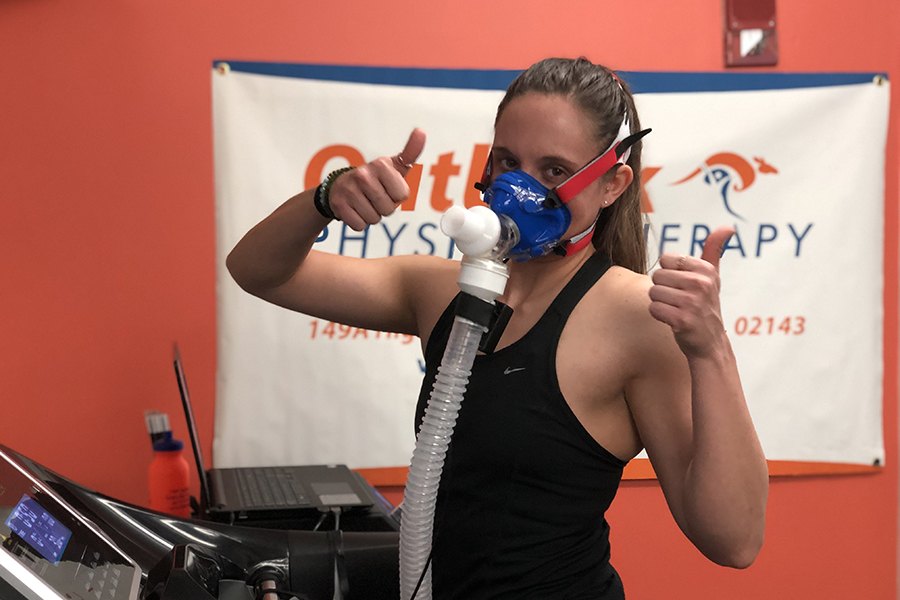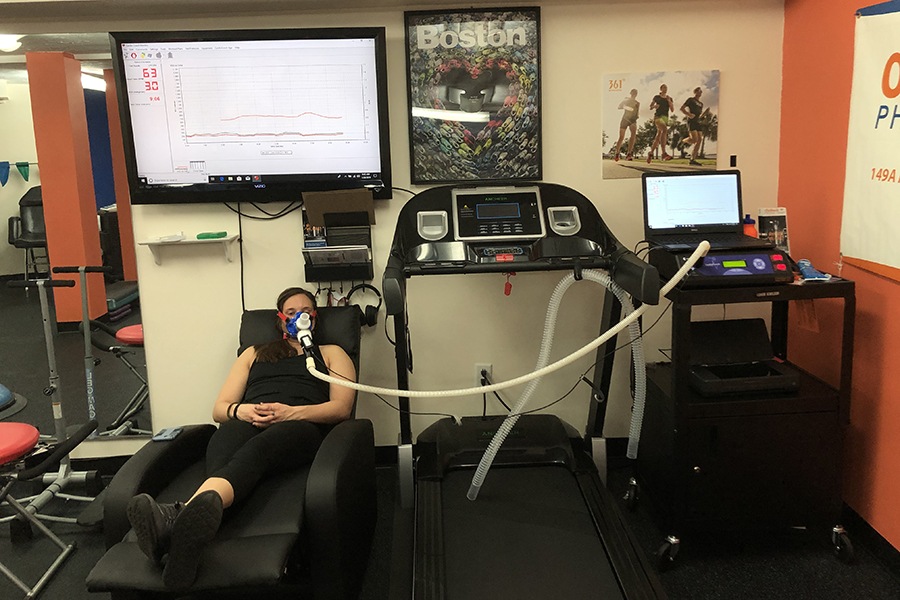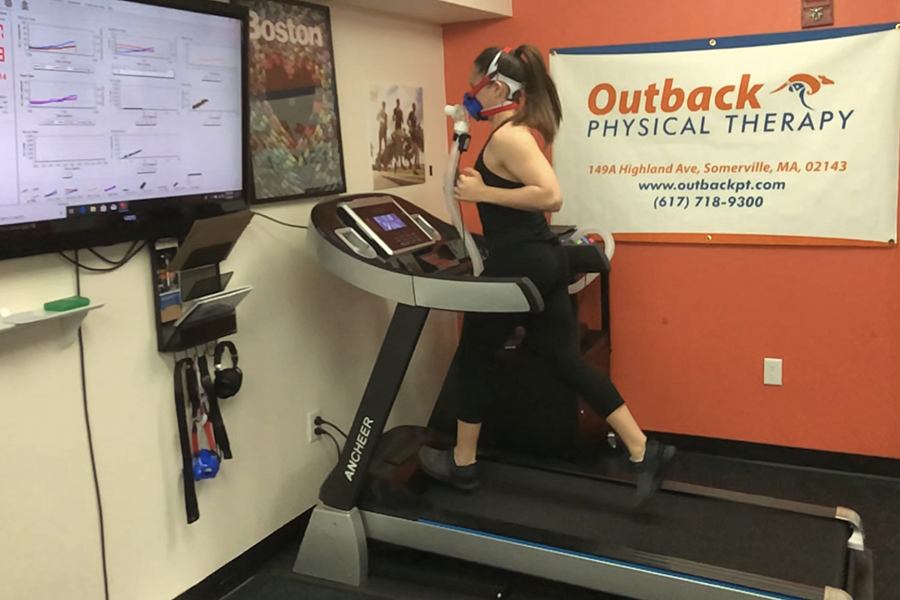I Tried It: VO2 Max Testing at Outback Physical Therapy
Measuring my oxygen output is something I never want to do ever again.

Photo by Ithamar Jotkowitz
I’m not really one for numbers.
I’ve never owned a FitBit to log my steps, I hate even thinking about opening MyFitnessPal to track my macros, and the only time I step on a scale is at the doctor’s office—and even then I turn my head away from the screen so I don’t know what the number reads. When the fine folks at Outback Physical Therapy in Somerville invited me to test my V02 max, every fiber in my being screamed no. I’ve never been interested in trying the process, which measures the maximum amount of oxygen a person utilizes during intense exercise. It’s beneficial for endurance athletes, but has never really appealed to me.
But numbers and data are powerful tools that help us individualize our training and nutrition needs, so I decided to keep an open mind and traveled to Somerville to run on a treadmill (another thing I am not too keen on) to huff and puff into a tube to measure just how fit I truly am.
That is essentially what your VO2 max is—a measurement of how in shape and physically fit you are. As described by Ithamar Jotkowitz, founder and clinical director at Outback PT and the one who administered my test, “If 100 units of oxygen were coming your way, it’s the measurement of how many of those units your muscles would be able to utilize while exercising.”
The set of rules I was given beforehand included not eating for four hours prior to the test, not partaking in strenuous activity 24 hours prior, drinking 8-12 ounces of room temperature water 30 minutes prior, and taking absolutely no stimulants. By the time I got there, I felt tired, hangry, and a little hesitant. To get the most out of my testing, Jotkowitz gave me a heart rate monitor to fasten around my chest and first measured my resting metabolic rate (RMR). As he explains it, this is “how many calories you burn in a day without doing much of anything. Basically it’s how much energy your body requires for your brain waves to work, heart to pump, lungs to expand, etc.”

Photo by Ithamar Jotkowitz
Jotkowitz fastened a tight mask to my face with a small tube protruding out of the end where my mouth was (I felt like an alien creature in a Star Wars movie) and told me the only thing I needed to do was lie back in a recliner and relax, breathing normally. Simple enough, I thought, until I laid back in the recliner and realized that it’s really hard, and terrifying, to be breathing through a tube that is constricting your air flow. In some instances, I had to seriously concentrate on not hyperventilating. To my surprise though, the 15 minutes went by faster than I thought, and Jotkowitz removed the suffocating mask…for the time being.
We quickly reviewed the measurements, and then it was time to fasten the mask back on and hop on the treadmill. Jotkowitz explained how the VO2 max test would work: Every minute the gradient on the treadmill would go up and the speed would increase. I would continue running until exhaustion and then slow down to a walk while I recovered, keeping the mask on, and then the test would be over. He told me that he would stay by my side and ask for continual updates and instructed me to give him a thumbs up if I was good to go for the next minute or down if I needed to call it quits (because talking was completely out of the question with the mask on).
I asked how long people normally run for and he said anywhere between 10-13 minutes is average, but that sub-elite marathoners can last up to 17 minutes.
Okay, cool, I thought. I can totally make it for 10 minutes.
“But it’s the incline, not the speed, that normally gets people,” he says. Great, something to look forward to.
The test started with a slow walk and progressed in difficulty pretty quickly. I was determined to make it for those 10 minutes. But it quickly became harder and harder to breathe through the mask and I felt myself taking large, sucking breaths into my upper chest. At the 11th minute I tapped out.
Success, I thought.
When all was said and done, Jotkowitz told me to relax and drink some water while he analyzed the data and printed out forms for me to take home. Then, we sat down in his office so he could give me a full recap of my numbers and stats.
Summing it all up, I was surprised and pretty happy with how my body performed. We talked extensively about how you can look at nutrition guidelines or heart rate zones and make predictions about what might be best for you, but you’re always going to be a little bit off because that’s just what those things are: predictions. They may not not actually be ideal for your individual needs. Although I am not someone who needed or, quite frankly, wanted these numbers, I think they can be helpful for those who are plateauing, need some direction, or for athletes who are training to be the best of the best.
Jotkowitz told me that by testing for your RMR he can extrapolate how many calories you need in a day based off your lifestyle and activity levels. And your VO2 max can be used to determine your peak heart rate. From there, he can tell you what heart rate zones are appropriate for you to be working in to achieve certain goals. Plus it’s great information to have if you enjoy workout classes that are solely based off of those zones.
For me, personally, these numbers told me I’m pretty darn fit, explained why I’m hungry all the time, and if I ever decide to get back into half marathon training I have some natural endurance talent—thank you 18+ years of playing soccer. Jotkowitz also opened my eyes to the fact that most often when people get these tests done, they realize they should be running less and eating more, which is news we can all enjoy.
At the end of the day, I say proceed with caution when it comes to numbers and data. They’re great tools and measurements of success, but with that being said, at an earlier stage in my fitness journey numbers like these would have derailed me. I choose to eat intuitively and I only track the weight on my barbell. Everything else feels like icing on the cake, or maybe just sprinkles—interesting to look at and fun to use in special circumstances, but not completely necessary all of the time.

Photo by Ithamar Jotkowitz


